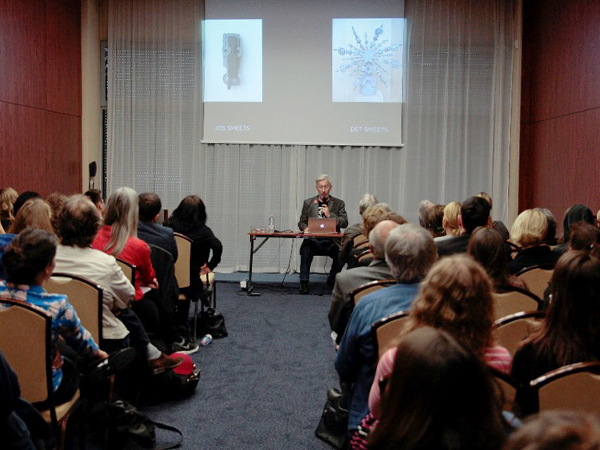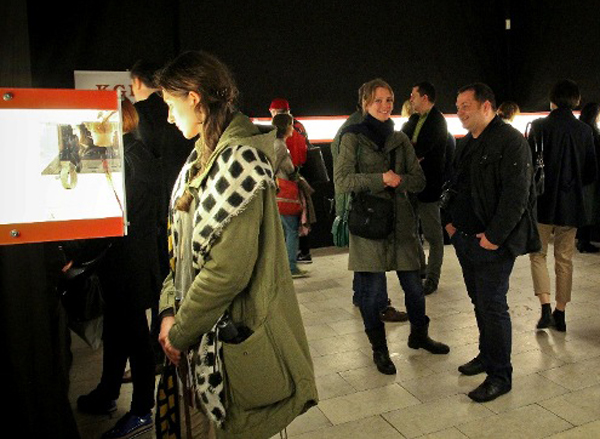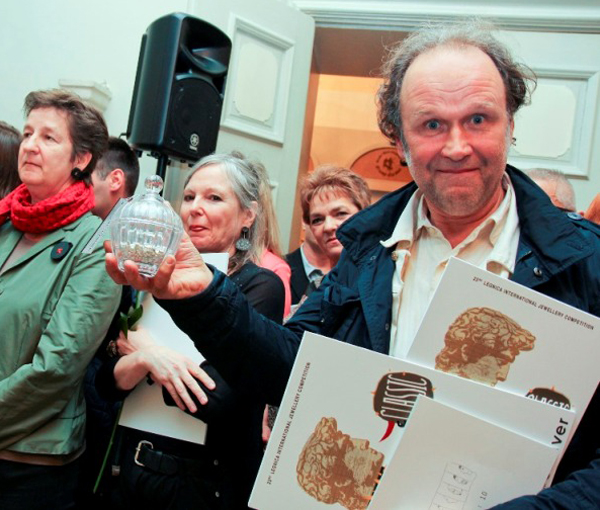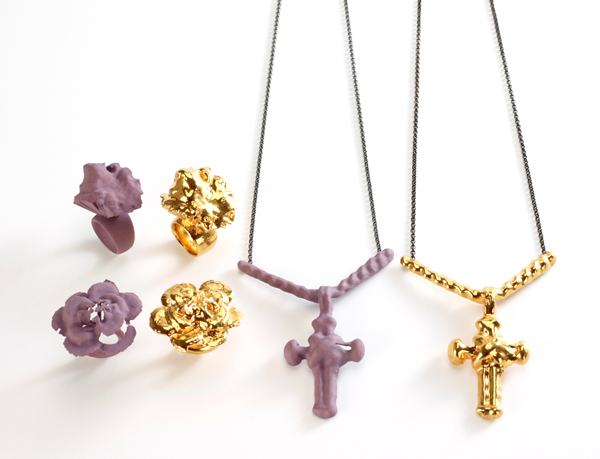Legnica Jewellery Festival SILVER
April 22–June 8, 2014
The Gallery of Art in Legnica, Legnica, Poland
Before I embarked from Edinburgh, Scotland, via Berlin, for Legnica (pronounced Leg’nitsa), Poland, a university colleague quipped, “Break a Legnica.”[1] At the time it made me laugh. I don’t know if you are familiar with the expression, understand the joke, or if it even translates to another culture. As such, there is always a risk of meanings being lost in translation,[2] as wonderfully depicted in Sofia Coppola’s film of that title. The contemporary jewelry art world can be like this, too.
On my return after a journey that included four flights, Berlin’s U-Bahn, several taxi journeys (the longest lasting 25 minutes, the shortest merely three), eight hours of Polish trains, three days of rain, all climaxing with getting stuck in a one-person elevator between floors in Berlin—I shouldn’t still be smiling … but oddly I am, and I just can’t help myself.

I had been to Legnica before, in 2010, exhibiting work from my department at the Edinburgh College of Art (eca) in Silver Schools, part of the festival that showcases the metalwork and jewelry of three invited international schools each year. That year eca exhibited work next to Fachhochschule Trier Idar-Oberstein and Escola d’art del Treball, Barcelona, Spain. So it seemed somehow fitting that this year Theo Smeets, professor at Trier Idar-Oberstein, and I both had parallel solo shows of selected past work during the festival. That is why I made the journey this year.
As you may have guessed, Legnica is not simple to reach by public transport. The nearest airport, Wroclaw, is a 40-minute journey away, (unless you are with a fast, if disconcerting, local driver). Determined to avoid the ubiquitous Ryanair flights that feed Wroclaw, I opted for flights to Berlin and a train to Legnica.
Legnica is small Polish town, formerly most famous for a battle where local miners, and quite possibly metalworkers and jewelers, helped knights defeat the Mongols in 1241. In more recent history, it has been steadily building a reputation for its promotion and celebration of all types of jewelry and silver. It is a place where you can find charming medieval architecture alongside less appealing modern buildings. This juxtaposition of opposing styles and tastes was to a certain degree repeated in the range of exhibitions and talks. There were clashing styles and mixed levels of jewelry throughout the festival, but it was good to see so many people from the jewelry world involved so confidently in different ways on this diverse platform. People gathered in Legnica from around the world to share their passion for jewelry and contribute to a genuine atmosphere of enquiry and celebration far more intimate and relaxed than larger events like Schmuck. The event and attending participants (primarily students, makers, academics/teachers, gallerists, trade sponsors, and the wider public and town community), reminded me very much of the Ars Ornata meetings that used to run every two or three years and appeared to end in 2007 with the excellent city-wide event in Manchester. There was a real sense of civic pride and of the work being warmly received and celebrated by an aware and interested public.

Unlike some of the delegates with slightly lower stamina for lectures, I held on and stayed for all the talks. Theo Smeets’s charming and often humorous lecture about his origins and work was very engaging. However, I would have preferred to have heard more about his work and less about the course at Fachhochschule Trier, Idar-Oberstein. I also enjoyed the young group of jewelers known as the Plateaus Jewellery Project. It consists of Katharina Dettar, Edu Tarin, Barbora Dzurákova, and Patrícia Correia Domingues, all colleagues who met through the influential Masters program at Trier after various previous European courses. Their installation, achieved in collaboration with graphic designers Marta Veludo and Manuel Ocaña, was displayed in the Legnica Cultural Centre, Knights Academy. Their individual stands echoed the curved vaulted arches of the ceiling and were hand printed with monochrome graphic patterns. Their exhibition had opened the night before in this hall, alongside this year’s interesting Silver Schools work from The Academy of Fine Arts in Łódź (Poland), The Academy of Fine Arts in Gdańsk (Poland) and the Glasgow School of Art (Scotland).

At the conference, Dr. Marta Baran gave a fascinating and beautifully illustrated conference talk about Greek and Roman jewelry between the first and fourth centuries CE, illustrated by both archeological remains and paintings from the period. Mah Rana next gave a presentation on her long-running project, Jewelry Is Life, and ‘Meaning and Attachments’, which I had first seen at Fabrica in Brighton when it began in 2001, and then a few years later in Manchester. The project has been an ongoing written/audio and photographic record of people’s personal connections to the jewelry that they wear. I was interested to hear some conclusions or critical reflective analysis from this proactive collection of 1500 stories and photographs, but was left feeling slightly disappointed by the simple, if engaging, account of the project, listing the countries it had been to, the balance of gender and range of ages of participants, and findings such as people wear jewelry they “never take off or never leaves them.”

One of the few genuine attempts to create a dialogue between the talks came after Rana’s presentation. Australian jeweler Felicity Peters, who was in the audience, asked, “As you have retrained in psychology, I would be interested to hear your opinion (Mah Rana) as to why so few jewelry makers wear their own work yet expect others to buy it?” Unfortunately the translator, not anticipating a request for his services again and to the clear chagrin of Peters, missed her demand that her question be first translated into Polish. Once finally translated to Polish and back again (with no obvious rationale since the talks so far—with audience agreement—had been in English), the delay had a least bought Rana some valuable time to think on her feet and very neatly sidestep the answer to a problematic question by elegantly asking the audience to indicate with a show of hands who was wearing their own jewelry. More than half raised their hands, which was a pretty clear visible reply. (If Rana had had a camera, the picture might have made a multiple case study for her project!) As it was, I was left with a sense of not knowing where the true objective of this long-running project truly lies. The recording of stories and memories related to people’s general personal attachment to jewelry—without further mining the information gathered in greater depth—seems to be an endless and open task.
The back-and-forth between translator, speaker and participant did seem to capture the sense that occasionally the events, the language barriers, and visibly the weather clashed. I should mention, in particular, the long and often protracted opening speeches, the Q&A sessions for the artists that were not really necessary or in fact listened to and which often could not be heard or understood due to the venues’ back noise, the multiple locations, or the wet and windy weather bearing down on increasingly weary crowds driven on from event to event.
The title of this year’s competition was Classic, on first appearance a clear and universal theme, but seeing the range of all the connected exhibited works it became apparent the interpretation of this title varied wildly by both participants and judges alike. Sławomir Fijałkowski (termed the competition’s “consultant”) invited participants (as far as I understand) to “discover the timeless” by any of the means or with any materials open to jewelry makers today. Well, at least that is my pithy translation to part of Fijałkowski ‘s brief for the competition. At 100 words, the brief was far from concise, including sentences like “economic pressure of efficiency forced the traditional craftsmanship into the sphere of anthropological phenomena,” and like so many instances and occasions, one was left feeling somehow something had been once more “lost in translation.”

Seven hundred and six pieces were submitted to a jury (Sławomir Fijałkowski, Maria Magdalena Kwiatkiewicz, Kai-Yin Lo, Graziano Visintin, Peter Bauhuis), which selected just over 50 pieces for the main exhibition. I was impressed by the democratic spirit shown by the organizers, who exhibited the non-selected work in a parallel exhibition titled Hollownia. There were some impressive pieces in this second exhibition, and Kwiatkiewicz states, “I am regretful about the fact that it was not possible to increase the main exhibition and extend the catalogue”. Yet the catalogue was not unsubstantial and at 70 full-color pages and a double-page spread for each artist, it is hard to see how this would be possible, unless perhaps the five judges had not been given the same generous space as the exhibitors to promote themselves. Other exhibitions often take the approach of inviting the judges to enter or select work on the themes of the exhibition. This would have added another dimension to both the exhibit and the catalogue rather than 10 additional pages of unnecessary background easily summarized in a short biography.

Michel writes, “I wanted to steal and so devalue jewellery and luxury objects via photogrammetry.” Not being able to attend on the night, he gave the best acceptance speech by sending a delightful animated digital facsimile of himself that echoed the virtual and pale, shadow-like imitation of real life that his pieces captured. Second prize went to the simple yet deserving work of Sungho Cho (South Korea) and third prize to Ferràn Iglesias (Spain), with his elegant if conservative necklace of repeated cages of golden wire containing bright green stone gems.

Returning to the film Lost in Translation, it contains one heart-to-heart moment of disclosure between Johansson’s character, Charlotte, who confides to Murray’s Bob, “I just don’t know what I’m supposed to be.” He replies, “You’ll figure that out. The more you know who you are, and what you want, the less you let things upset you.”
Take this sage advice with you to Legnica next year and you are sure to embrace the experience.
Index Image: Mah Rana and a gentleman who lent his camera to her for the duration of the event, photo: Mah Rana and unknown gentleman
[1] “Break a leg” is an idiom in theater used to wish a performer good luck in an ironic way. Well-wishers typically say “break a leg” to actors and musicians before they go onstage to perform. The origin of the phrase remains obscure. (Source: Wikipedia.)
[2] Lost in Translation is a classic 2003 American comedy-drama film written and directed by Sofia Coppola featuring Bill Murray and Scarlett Johansson in near perfectly cast roles as Bob the faded movie star and Charlotte the neglected young married woman. They meet in Japan, where both suffer confusion and hilarity due to the cultural and language differences sharing time abroad.




